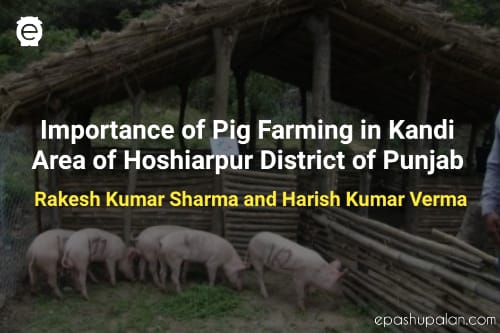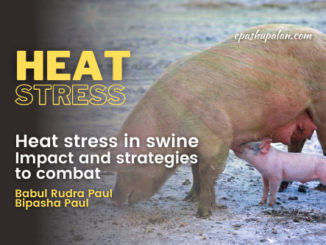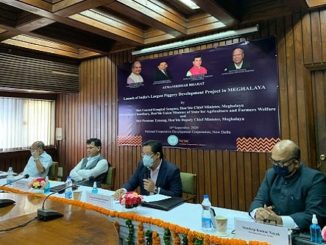The Kandi area in Hoshiarpur district is located at the foot of Shivaliks and covers the sub-mountainous undulating plain with a slope of more than 16 meters per kilometer which progressively decreases towards west side of the district. This area constitutes 53 percent of total geographical area of Hoshiarpur district. The major constraints of this area are insufficient ground water and erratic rainfall distribution, excessive run off and sediment loss, low fertility of soils, small land holdings and wild animals. Agriculture is not so remunerative under such conditions. Livestock farming is the best bet. One can make good progress by raising small animals like pigs or goats. In this write-up, we will discuss different opportunities for pig farmers in Kandi area of Hoshiarpur district of Punjab.

Pig farming can be initiated with very small financial resources. Usually, the business is started with five piglets (three female and two male) and each piglet costs around Rs 4000-5500. Pig sty can be constructed with a meagre amount of capital. Even the locally available raw material can be employed in the construction of a pig shed. In Kandi area, bamboo and sarkanda is available in plenty. Both can be effectively used to construct a thatched sty as seen in Fig.1. Thus, very small amount of money will be needed to venture into pig farming in comparison to dairy farming.

Pigs can be raised in a relatively small area. A sty of 100 square feet (10’ X 10’) area can easily accommodate 8-10 piglets of 1-3 month age or 5-7 growing pigs of 3-7 month age or 3-4 adult pigs of 8-12 months. Under similar conditions, only two buffaloes can be lodged.
The farmers who opt pig farming as source of livelihood start earning earlier than dairy farmers. Under normal circumstances, a sow usually gets conceived for the first time when she is 8-12 months old and she farrows 114 days later. The piglets of this very first litter reach marketable weight within next 8-12 months. Thus, a pig farmer begins to earn roughly 22-24 months after starting the business with two month old piglets. In comparison to this, a dairy farmer has his first earnings 4-5 years after starting business with young calves.
Selling pigs is not a big deal. Whole of the lot can be sold in one go. Thus, it is very easy to leave the business altogether. One can have good premium if one is able to market his pigs on certain special occasions in the year. The occasions are – festival of Diwali, Dushera, Holi, Lohri and New Year Day. The rustic folk in Punjab usually celebrate these festivals with traditional cooking of pork or chevon or chicken. Because of high demand of these items, one can fetch good returns on such occasions.
Growth is very fast in the business of pig farming. Normally, a sow farrows twice in a year and she produces 8-12 piglets in each litter. The gilts become ready for breeding well within a year. The gestation period is also relatively small. Every aspect of cattle/buffalo breeding is longer in duration.
Pigs are omnivorous in nature. They can consume almost all kinds of things/material. They can thrive well on swill-kitchen waste, hotel waste, grain market waste, fruit waste, slaughter house waste, leftovers of agricultural crops and fish market. Thus, pigs can very effectively convert the waste material into a very nutritious animal protein i.e. pork.
Pigs grow faster as compared to other domestic animals. Thus, feed efficiency is better in swine. They can produce higher amount of muscle mass with similar quantity of feed.
The dressing percentage is also better with meat of the pig. It is around 65-85 percent in swine while it is less than 65 percent with other meat producing animals. Pig meat is bestowed with many vitamins like thiamin, niacin and riboflavin. Pigs also have good amount of fat. However, it is layered separately alongside muscles. Pig fat can be employed in the manufacture of paints, soaps or other chemicals. It can also be included in poultry feeds.
Pig farming can be started even without acquiring sophisticated technical knowledge or skill. The farmers can easily learn the basic maneuvers from existing farmers in the area. The landless farmers can also engage themselves easily in this profession. Even the female folk in the family can manage the events when the owner is away for some important assignment. The equipment or implements needed in this business are also not so dear.
Pig is a very neat animal. If they are kept on clean and dry flooring, the shed and its surroundings will remain free from any objectionable stinks.
Pig excreta are full of nutrients. It can improve soil fertility if used as a fertilizer. It can also be included in the diet of fish. Integrated farming can prove more beneficial when pigs are raised on the banks of fish ponds. However, because of scarcity of water, this concept of integrated farming is applicable to some pockets only where canal water is available.
Organic farming is the order of the day. Bane (limitations) of the Kandi area can prove beneficial for organic pig farmers. Moreover, the consumers these days prefer to purchase things from small farmers because of their faith or reliability on them.

Thus, pig farming as small units can easily be established in Kandi area of Hoshiarpur district. Guru Angad Dev Veterinary and Animal Sciences University also guides the budding pig farmers in construction of pig sheds. The latest pig management practices and skills are also imparted to the beginners at their own farms. Extension training programmes in pig farming are also regularly organized by the University at its main campus as well as in Kandi area itself. Advisories on various aspects of pig farming are also relayed to the concerned farmers through SMS, University website www.gadvasu.in, radio and TV programmes and through telephonic conversations.







Be the first to comment